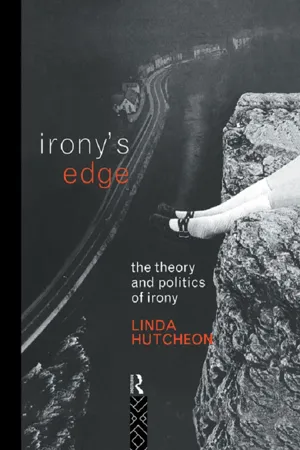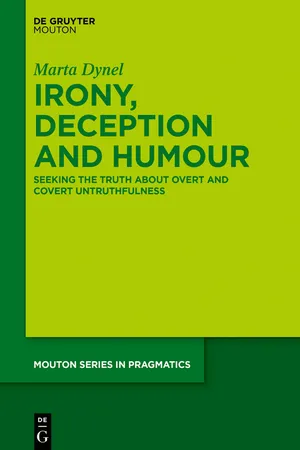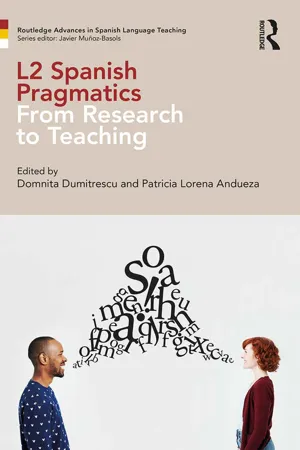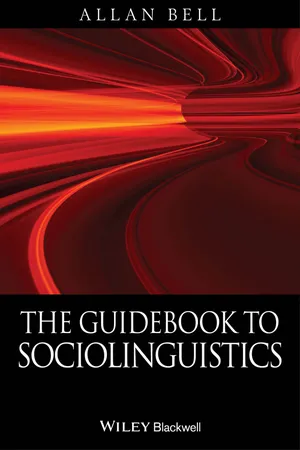Languages & Linguistics
Situational Irony
Situational irony occurs when there is a discrepancy between what is expected to happen and what actually happens in a situation. It is a literary device used to create a humorous or dramatic effect in a story or play. Situational irony can be found in all forms of literature and is often used to highlight the absurdity of human behavior.
Written by Perlego with AI-assistance
Related key terms
4 Key excerpts on "Situational Irony"
- eBook - ePub
Irony's Edge
The Theory and Politics of Irony
- Linda Hutcheon(Author)
- 2003(Publication Date)
- Routledge(Publisher)
The difference here is in the intention: lies are not usually intended to be interpreted or decoded as lies ; on the contrary, ironies are really only ironies when someone makes them happen. Like paradoxes (Sainsbury 1988: 1), lies are permanently intended contradictions; ironic meanings, however, are formed through additive oscillations between different said and unsaid meanings. Irony arises from “the interaction of terms upon one another,” all “integrally affecting one another” (Burke 1969a: 512), even if the unsaid is a sort of primus inter pares, weighting the evaluative force of irony’s edge to what is unstated, even while oscillating with what is stated. As a possible way out of the conceptual restrictions put in place by the long and powerful tradition of one particular semantic definition of irony, I am suggesting here that we stop thinking of irony only in binary either/or terms of the substitution of an “ironic” for a “literal” (and opposite) meaning, and see what might happen if we found a new way of talking about ironic meaning as, instead, relational, inclusive, and differential. If we considered irony to be formed through a relation both between people and also between meanings— said and unsaid—then, like the duck/rabbit image, it would involve an oscillating yet simultaneous perception of plural and different meanings. II THEATER GOES TO THE MOVIES: HENRY V I have chosen the 1989 film of Shakespeare’s play Henry V by the young British actor and director, Kenneth Branagh, as my case-study for such a rethinking of the semantics of irony. While a simple antiphrastic model might well work for straightforward, easily contextualized examples (“What splendid weather” uttered during a blizzard), I have been suggesting that longer and more complex examples are not easily explained in terms of opposition alone. My major focus here will be on Branagh’s film in its relations with both the original play and the famous 1944 wartime film of it by Laurence Olivier - eBook - ePub
- Marta Dynel(Author)
- 2018(Publication Date)
- De Gruyter Mouton(Publisher)
The hallmark of all irony can be thought of as a mismatch between the basic (typically, but not always, literal) meaning of an utterance and the implicated intended meaning. However, this common denominator does not suffice as the primary definitional component of irony (Bredin 1997; but see Garmendia 2014) for it fails to distinguish irony from other means of communicating implicated meanings. This is why the notion of meaning opposition is endorsed here. What follows naturally from the above description is that irony must be intentionally produced, which most academics take for granted. However, Gibbs et al. (1995) introduce the concept of “unintentional irony” (see also Muecke 1973; Gibbs and O’Brien 1991), which arises when the speaker does not mean his/her utterance to be ironic but it is perceived as being such by the hearer. Similarly, arguing that irony may not be intentional, Gibbs (2012) discusses cases which can actually be grouped into three categories: Situational Irony and dramatic irony (neither of which is a stylistic figure and thus neither is relevant here), as well as cases where the hearer reads irony into an utterance which was not meant as ironic. 63 Such a situation seems to be more of a misunderstanding, a mirror reflection of which is the hearer’s failure to perceive the ironic nature of an intentionally ironic utterance. On the other hand, the case of “I would never be involved in any cheating” said by someone who has unknowingly been involved in cheating (Gibbs 2012: 107) constitutes an example not of “unintentional irony” but of Situational Irony of whose presence the speaker is oblivious. This is compatible with Muecke’s (1973: 35) distinction between “the intentionally ironical” and “the unintentionally ironic”, the latter of which concerns the situation or event and the victim’s unawareness of it - eBook - ePub
L2 Spanish Pragmatics
From Research to Teaching
- Domnita Dumitrescu, Patricia Lorena Andueza(Authors)
- 2018(Publication Date)
- Routledge(Publisher)
Irony is one of the hardest pragmatic phenomena to investigate. Contrary to the rhetorical explanation, which states that irony consists of a figure of speech in which one says the opposite of what is really meant, pragmatics brings situational contexts into play, along with the speaker’s intentions and the listener’s interpretations. The stance adopted in this chapter is rooted in neo-Gricean theories (Ruiz Gurillo and Padilla García 2009) because irony has an inferred conversational meaning, insofar as the communication transmitted through an ironic statement is possible thanks to an inversion of the conversational maxims that Levinson (2000) takes up and modifies from Grice ([1975] 1991). Some considerations about the pragmatic functioning of irony are offered below.2. Verbal irony from a pragmatics perspective
The conception of traditional rhetoric, wherein irony entailed saying the opposite of what is really meant, has been abandoned by authors such as Haverkate (1985), who argues that contradiction does not suffice to unify all the ironic phenomena, or Ruiz Gurillo and Padilla García (2009), who deal with irony from a pragmatic point of view, since it is the context and the interlocutors that will determine an ironic utterance. Furthermore, the existence of a contradiction does not characterize utterances as ironic because there may be utterances with irony and a marked figurative sense that lack an implicit contradiction even with humor.What reveals the presence of irony is very often not an opposite meaning but rather a different one. This approach justifies the decision to study irony as a pragmatic phenomenon and to propose an analytical theory that arises from neo-Gricean theories when speakers have an explicit intention to communicate something when they use an ironic utterance. They consequently want their listener to infer what they have not said so that the complete meaning of their utterance is specified.Relevance Theory has taken a position in this regard, suggesting an explanation for irony based on the concept of echo. According to Wilson and Sperber (1992, p. 272), “relevance theory claims that it is ironical because it is echoic: verbal irony consists in echoing a tacitly attributed thought or utterance with a tacitly dissociative attitude.” Therefore, irony is studied as a process of distancing oneself from a thought or an utterance attributed to someone, and it will always entail a context that can be understood as a mocking echo. Hence, the goal of this chapter is to prove that not all ironic utterances contain that mocking echo; in fact, irony can actually lack the mocking component altogether. - eBook - ePub
- Allan Bell(Author)
- 2013(Publication Date)
- Wiley-Blackwell(Publisher)
6
SITUATED LANGUAGE
Language does not occur in a vacuum. It is situated, contextualized. There are speakers and hearers, a time and a place, a topic and a purpose. This chapter introduces the main ways in which sociolinguists have tried to describe and make sense of how everyday language is moulded by – and moulds – the situation of its usage.We then go on to examine several approaches to how language operates as part of interaction. The chapter deals with the use of language to do things through speech acts, and the ways in which politeness (or impoliteness) affects how we address another person. It looks in detail at the sociolinguistics of interaction, how that can lead to miscommunication between people, and the ways in which gender dynamics affect conversational patterns such as turn taking. Underlying this is a concern for the micro detail of everyday conversation that is informed by the methods and theories of anthropology, in particular by ethnographic approaches.6.1 SITUATIONS, CONTEXTS AND DOMAINS
A situation is the extended social occasion within which speech occurs (Hymes 1972). Situations are as variegated as human encounters – ‘card games, ball-room couplings, surgical teams in operation, and fist fights’, as Erving Goffman put it in a brief early paper on ‘the neglected situation’ (1964: 135). Language is one player in situation, although most situations are not primarily defined by language but by the shared activity. They may, however, contain conventional language elements, and speech may even be the main activity or prerequisite of what occurs. A committee meeting, a trial in court, a school class are all speech situations – they cannot in fact take place without speaking, and speaking that is appropriate to the specific situation.
Index pages curate the most relevant extracts from our library of academic textbooks. They’ve been created using an in-house natural language model (NLM), each adding context and meaning to key research topics.



